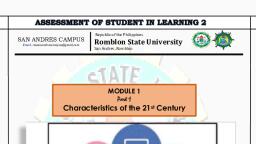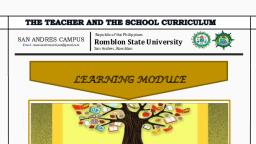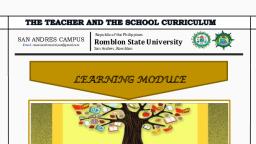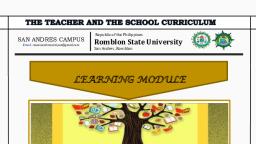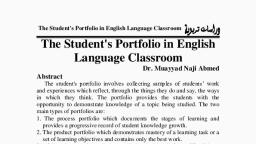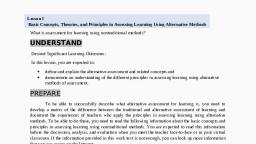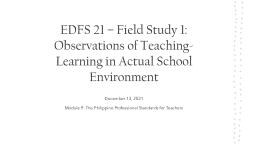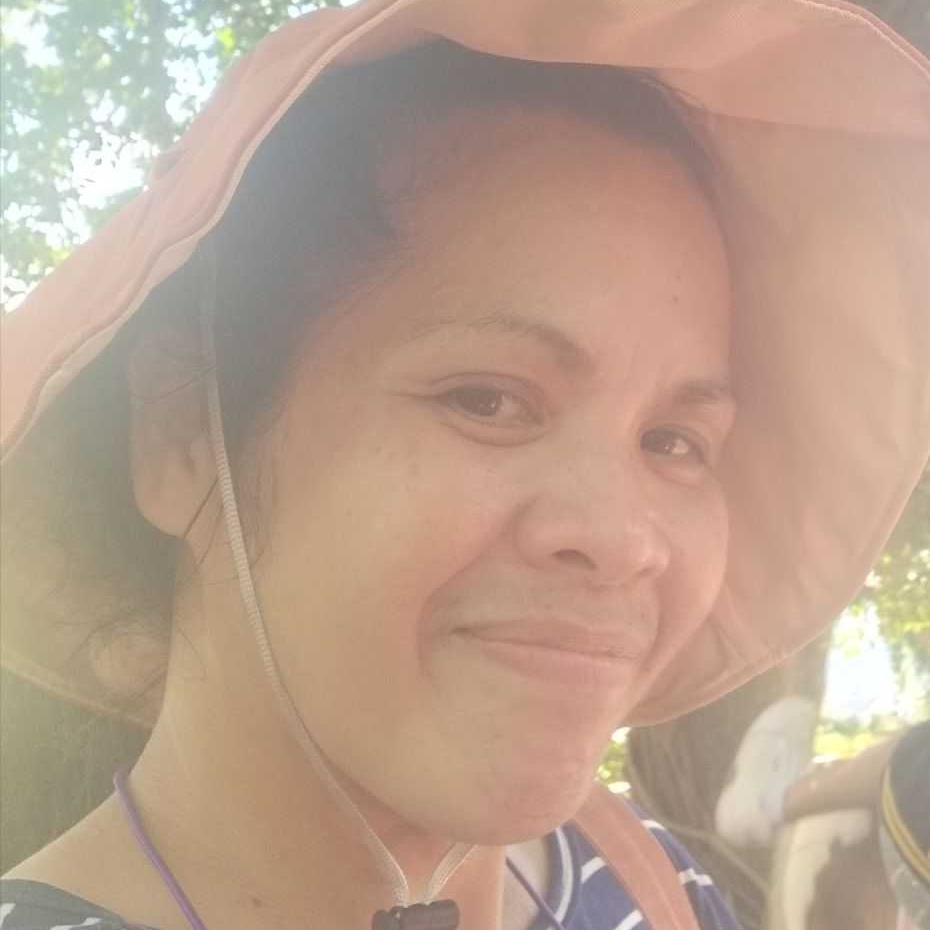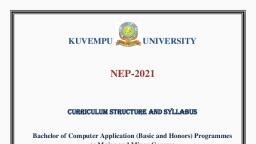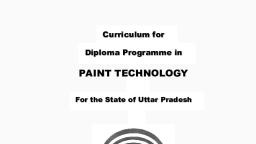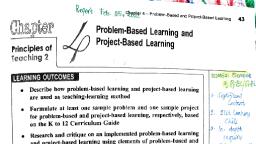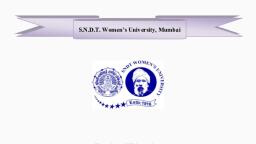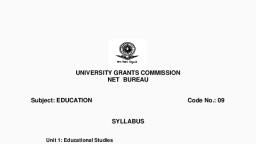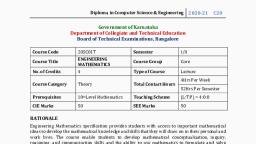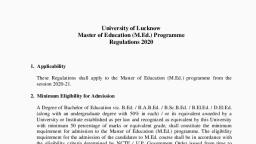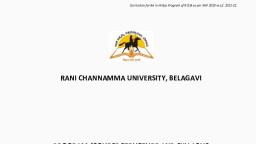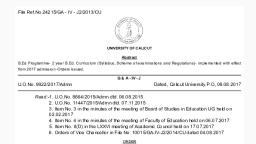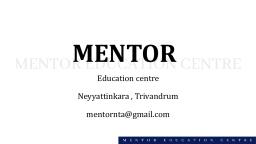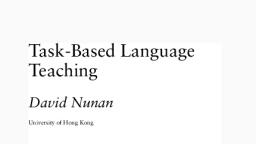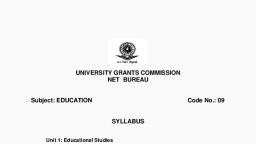Page 2 :
MODULE 5, I, , Evaluating the Curriculum, Module Overview, , This module is all about evaluation in the context of its definition and the, role of the teacher as an evaluator. It will present the ways of evaluating the, curriculum as written, planned or implemented. It will reference popular, curriculum models currently used educational programs here and abroad., Curriculum evaluation is premised on the concept of alignment of planned,, written, and implemented curriculum. It is an attempt to answer two big, questions as:, 1. Do planned courses programs, activities as written and implemented, produce desired outcomes?, 2. How can these school curricula be improved?, , Desired Learning Outcomes, • Expanded knowledge about different curriculum evaluation models., • Understood how the curriculum can evaluated by assessment of learning, outcomes., • Understand the connections between planning and implementing and, evaluating in the curriculum process., • Matched the levels of learning outcomes with appropriate assessment, tools, , LESSON 1, , What, Why and How to evaluate a, Curriculum, , Content Focus, , Curriculum Evaluation: A Process and a Tool, Do you have an understanding of what curriculum evaluation is, all about? Is it synonymous to assessment of learning?, • As a process it follows a procedure based on models and frameworks to, get to the desired results., • As a tool, it will help teachers and program implementers to judge the, worth of the program innovation or curricular change.
Page 3 :
Let’s look of how curricularist define curriculum evaluations. Read each, what each of them say, Persons, Ornstein, A. & Hunkins, F, (1998), , McNeil J. (1977), , Gay, L. (1985), , Oliva p. (1988), , Definition, Curriculum evaluation is a process done in order to, gather data that enables one to decide whether to, accept, change, eliminate the whole curriculum of a, textbook., Evaluation answer two questions: 1. Do I have, planned learning opportunities, programmes,, courses, and activities as developed and organized, actually produce desired results? 2. How can a, curriculum best be improved?, Evaluation is to identify the weaknesses and, strengths as well as problems encountered in the, implementation to improve the curriculum, development process. It is to determine the, effectiveness of the returns on allocated finance., It is a process of delineating, obtaining and, providing useful information for judging alternative, for purposes of modifying, or eliminating the, curriculum., , Reasons for Curriculum Evaluation, Why is there need to evaluate a curriculum?, Here are some of the specific reasons:, • Curriculum evaluation identifies the strengths and weaknesses of an existing, curriculum that will be the basis of the intended plan, design or, implementation, • When the evaluation is done in the middle of the curriculum development, implemented curriculum can produce or is producing the desired results., • Curriculum evaluation provides information necessary for teachers, school, managers, curriculum specialist for policy recommendations that will, enhance achieved learning outcomes. This is the basis of decision making., ➢ In curriculum evaluation important process were evolved such as (a), assessment, (b) monitoring, (c) terminal assessment and (d) decision, making, Curriculum Evaluation Models, 1. Bradley Effectiveness Model, In 1985, L.H. Bradley a handbook on Curriculum Leadership and, Development. This book provides indicators that can help measure the, effectiveness of a developed or written curriculum.
Page 4 :
2. Tyler Objectives Center Model, Ralph Tyler in 1950 proposed a curriculum evaluation model which until now, continues to influence many curriculums assessment process. His monograph was, entitled Basic Principles of Curriculum and Instruction., 3. Danie Stufflebeam’s Context, Input, Processes Product Model (CIPP), The CIPP model of curriculum Evaluation was a product of Phi Delta Kappa, for decision making. These are the four stages of program operation. These, includes:, 1. Context Evaluation – assesses needs and problems in the context for, decision makers to determine the goals and objectives of the, program/curriculum., 2. Input Evaluation – asses alternative means based on the inputs for the, achievement of objectives to help decision makers to choose options of, optimal means., 3. Product evaluation – compares actual ends with intended ends and leads, to a series of recycling decisions., 4. Stake Responsive Model. Responsive model is oriented more directly to, program activities that program intents. Evaluation focuses more on the, activities rather than intent or purposes., 5. Scriven Consumer Oriented Evaluation. Michael Scriven, in 1967 introduced, this evaluation among many others when education products flooded the, market. Consumers of educational products which are needed to support, an implemented curriculum often used consumer-oriented evaluation. These, products are used in schools which require a purchasing decision. These, products include textbooks, modules, educational technology like software’s, and other instructional materials. Even teacher and schools nowadays write, and produce theses materials for their own purposes., A Simple Way of Curriculum Evaluation Process, For every simple and practical way of curriculum evaluation, responding to, the following questions will provide an evaluation data for curriculum decision. Just, ask the following questions and any NO answer to an item will indicate a need for, a serious curriculum evaluation process., 1. Does the curriculum emphasize learning outcomes?, 2. Does implemented curriculum require less demands., 3. Can this curriculum be applied to any particular level? (kindergarten,, elementary, secondary, tertiary level), 4. Can the curriculum aspects be assessed as (a) written (b) taught (c)supported, (d) tested and, (e) learned, 5. Does the curriculum include formative assessment?, 6. Does the curriculum include summative assessment?, 7. Does the curriculum provide for quantitative methods of assessment?, 8. Does the curriculum provide for qualitative methods of assessments, 9. Can the curriculum prove the data needed for decision making?, 10. Are the findings of evaluation available to stakeholders?
Page 5 :
In summary, whatever models of curriculum evaluation to be used, ASCD,, 1983 suggests the following steps., Steps in Conducting a Curriculum Evaluation, Steps, 1. Identifying primary, audiences, 2. Identifying Critical, issues/problems, 3. Identifying Data, Sources, 4. Identifying, techniques for, collecting data, 5. Identifying, established, standards and, criteria, 6. Identifying, Techniques in data, analysis, 7. Preparing, Evaluation Report, 8. Preparing modes, of display, , LESSON 2, , What to Consider, Curriculum Program Sponsors Managers and, Administrators, School Heads, Participants (Teachers, and Students) Content Specialist; other stakeholders., Outcomes (expected desired, intended) Process, (Implementation)Resources (Inputs), People (teachers, students, parents, curriculum,, developers) Existing documents; Available records;, Evaluation Studies., Standardized Test, Informal tests; Samples of Students, Work; Interviews; Participant Observations, Checklist,, Anecdotal Records, Standards previously set by agency (DepEd, CHED,, Professional Organization), , Content Analysis, Process Analysis, Statistics,, Comparison, Evaluation Process, Written; Oral; Progress; Final; Summary; Descriptive;, Graphic, Evaluative and Judgmental; List of, Recommendations, Case Studies; Test Scores Summary; Testimonies; Multi, media representation; Product Display (exhibits);, Technical Report, , Curriculum Evaluation Through Learning Assessment, , Take Off, Let us find out in this lesson, that assessment of learning is an evaluation, process that tells whether the intended learning outcomes through the teachinglearning process, have been converted into achieved learning outcomes., Further, as future teachers, you should also understand and interpret the, grading system that has been derived from assessment of learning
Page 6 :
Content Focus, Achieved Learning Outcomes, OOuOutcomesOutcomes, , • Is defined in outcomes-based education as a product of what have been, intended in the beginning of the learning process. Indicators of learning, outcomes which are accomplished are called achieved learning, outcomes. Standards and competencies are use as the indicators and, measures of these outcome., , The eighth levels of complexity of learning outcomes are based on three, domains:, ❖ Knowledge, skills, and Values, ❖ Application, ❖ Responsibility-degree of independence, Knowledge, Process, Understanding, Performance (KPUP) – Levels of Learning, Outcomes, • Knowledge, Process, Understanding, Performance reflects different learning, outcomes that are arranged in hierarchy or complexity. Knowledge being, the basic level of learning outcomes and Performance being and, advanced level of learning outcomes., Assessment Tools for each level of Learning Outcomes, Knowledge, Process, Understanding (KPU) Learning Outcomes, • Students who can show that they have gained knowledge can apply such, knowledge and have achieved several meanings on the particular, knowledge have achieved the learning outcomes. The three types of, learning outcomes and on the different levels can be assessed in many ways, with the appropriate tools., Types of Test to Measure Knowledge, Process, and Understanding, 1.1 Objective Tests. Test that requires only one and one correct answer. It is difficult, to construct but easy to check., 1.1 Pencil-and-paper. As name suggests, the test is written on paper and, requires a pencil to write. However, with the modern times, a pencil-and-paper, test can also be translated to an electronic version, which make the test, “paperless.”, 1.0.1 Simple Recall. This is the common tool to measure knowledge. There are, varieties of Simple Recall Test, to include:, ❖ Fill in the blanks, ❖ Enumeration, ❖ Identification, ❖ Simple Recall
Page 7 :
1.1.2 Alternative Response Test. This is the type of pencil and pencil test, where two, options or choices are provided. This item can be stated in a question or a, statement from., Examples of this are:, ❖ True or False – Example: The Philippine population has reached one million., ❖ Yes or No – Example: Has the Philippine population reached one million?, ❖, , 1.1.3. Multiple Choice Test. This is the type identified as the most versatile test type, because it can measure a variety of learning outcomes. The list suggested, solutions in words, numbers, symbols or phrases are called ALTERNATIVES, OPTIONS,, or CHOICES. There should be three to five options in each item. The correct, alternative is called the ANSWER while the remaining options or choices are called, DISTRACTERS, DISTRACTORS, or DECOYS. Some multiple-choice items presented, with a STIMULUS MATERIAL., ❖ Correct Answer Type. Other alternatives are correctly wrong and only one is, the correct answer. This can be constructed in either direct question or, completion of the sentence., Example:, 1. Direct Question:, What is NOT a member of ASEAN 2015 Economic Community?, A. Vietnam, C. Malaysi, B. Korea, D. Philippines, 2. Incomplete Sentence, A country in Southeast Asia which is not a member of the ASEAN 2015, community is ____., A. Teacher, C. Books, B. Learner, D. Principal, 1.1.4 Matching Type Test. The most common matching type test is made up of two, parallel columns, the firs column (A) is the premise that presents the problem and, column (B) provides the answer., 1.2 Subjective Test. Subject types test, answers through reflections, insights, and, opinion can be given through essay., 1.2.1. Essay test items allow students freedom of response. Students are free to, select, relate the present ideas in their own words., 1.2.1.1Restrected Response Item. This is like an expanded form of short answer type, objective test., Example: What are the main body parts of plant? Describe each part., 4., Post, 1.2.1.2 Laboratory, Expanded Activity, Response Item. The students is generally free to select any, 4.1, After, the, report,, display, the work, in front of, the, classroom., factual information that, can help, in organizing, the, response., 4.2Example:, Analyze each, groupthe, result, with, thenormal”, whole class., Comment, tern, “new, that refers to the environmental, 4.3 Make agreements, on, the, results, that, lead, to, conceptualization, condition and climate change.
Page 8 :
Assessment Tools to Measure Authentic Learning Performance and Products, (KPUP), • KPUP can be assessed through Performance Product, • These learning outcomes can be done through the use of authentic, evaluation., • Authentic evaluation is a test that measures real life tasks, performances,, and actual products., • The most common of the authentic assessments are the performance, assessment and the use of portfolio., Performance Assessment Tools, 1. Checklist is a tool that consists of a list of qualities that are expected to be, observed as present or absent. The presence is to be marked (/) and the, absence is marked (X), Example: Checklist on the use of microscope (10 pts.), Instruction: Observe the student in a laboratory activity with the use of, microscope. Check (/) the items which you have seen, which were done, appropriately and mark (X) items which appropriately done., ___ 1. Wipes the slide with lens., ___ 2. Places drop or two of culture on the slide, ___ 3. Adds few drops of water, ___ 4. Places slides on the stage, ___ 5. Turns to low power lens, ___ 6. Looks through eyepiece with one eye, ___ 7. Adjust mirror, ___ 8. Turns high power lens, ___ 9. Adjust for maximum enlargement and resolution, ___ 10. Records results., 2. Rating Scale is a tool that uses a scale in a number line as basis to estimate the, numerical value of a performance or a product., Example: Rating Scale for a Science Project (name/title), Instruction: On a scale 1to 10, with 1 as the lowest, and 10 as the highest score,, rate the projects on the following elements. Circle the choice of your answer., 1. Have a clear purpose/s, 2. Are relevant to environment problem, 3. Use local materials, …, , 1 2 3 4 5 6 7 8 9 10, 1 2 3 4 5 6 7 8 9 10, 1 2 3 4 5 6 7 8 9 10, , 3. Rubric for Portfolio. A portfolio is a compilation of the experiences as authentic, learning, outcomes presented with evidence and reflections. To assess the total, ____________________________________________________________________________, experiences as presented in a wholistic package, an assessment tool called a, rubric in utilized.
Page 9 :
Levels for Assessment for the Levels of Learning Outcomes, 1. Knowledge, 2. Process Skills, 3. Understanding, 4. Products Performance, • In other words, the levels of assessment follow also the levels of thinking skills, from lower level to higher level., , P, Placing Value to the Assessment Results from KPUP
Page 10 :
• The four levels may be employed in the formative assessment but the, result is no recorded. It will just tell how the students are progressing., • On the other hand, KPUP format is required for summative assessment, which are recorded for grading purposes., The interval scale of computed four levels learning outcomes are given Level, of Proficiency Description. This interpretation is used for all the learning areas or, subjects in basic education., , Placing Value to the Assessment Results in the New Grading System (DepEd, Order 8, s 2015, • Grades at the End of the Quarter Grading Period: Used of checklist,, anecdotal records and portfolios are used instead of numerical grades which are, based on Kindergarten curriculum., • Grade 1 to 12: The following guidelines should be followed:, 1. Learners are graded on three components every quarter:, (A) Written work (B) Performance Taks (C) Quarterly Tests, 2. These components are given specific weights that vary,, Table 3 Weighted Components for Grade 1 to 10., , 3. All grades are based on the weighted raw score 1 of learners’, 4. The minimum grade needed is 60 which when transmuted based on the, table is equivalent to 75 in the report card., Note:, 1. Written Work may include items in Level 1 -Knowledge and Level 3Understanding in the KPUP
Page 11 :
2. Performance Task may include items in Level 2- Process Skills and Level 4Products/Performance of the KPUP., 3. Quarterly exam may include of Levels 1 to 4., How are Grades are computed and the End of the School Year, • For Kindergarten: Checklist, anecdotal records and portfolios are presented, to the parents at the quarter for discussion., • The general average is computed by dividing the sum of all final grades by, the total number of learning areas. Each learning area has equal weight., • For Grade 1 and 12:, 1. The average of the quarterly grade produces the semestral grade., 2. The general average is computed by dividing the sum of all semestral, Final Grades by the Total Number of Learning Areas., Reporting Summative Grade by Quarter and Summative Grade at the End of the, Year, This modifies the previous descriptions performance in the KPUP. The values, and descriptions are reported to parents every quarter at the end of the year., Table 4 Grading Scale, Grading Scale (based on Transmuted Values), Descriptor, 90 - 100, Outstanding, 85-89, Very satisfactory, 80-84, Satisfactory, 75-79, Fairly Satisfactory, Belo 75, Did not meet expectations, ______________________________________________________________________________, , Lesson 3, , Planning, Implementing and Evaluating:, Understanding Connections, , Desired Learning Outcomes, • Understand the connections between planning and implementing and, evaluating in the curriculum process., , Content Focus
Page 12 :
• Planning, Implementing and Assessing are three processes in curriculum, development that are taken separately but are connected to each other., The cycle continues as each is embedded in a dynamic change that, happens in curriculum development., Key Idea: Planning as initial step in curriculum, , • It includes determining the needs through assessment. Needs would include, those of the learners, the teachers, the community and the society as these, relate to curriculum., • After the needs have been identified, the included outcomes are set., • Intended outcomes should be smart, specific, measurable, attainable, with, result, and with in the frame of time., • An example of curriculum plan is a lesson plan. It is written document. Many, planners would say: “A good plan is half of the work done.” So, in curriculum, development a well-written plan ensures a successful implementation., • The end product of planning is written document. Some outputs of curriculum, planning are lesson plans, unit plan, syllabus, course design, modules, books,, instructional guides, or even a new science curriculum plan., Key Idea: Implementation continues after planning, , What should implement?, • The planned curriculum which was written should be implemented. It has to, be put into action or used by a curriculum implementor who is the teacher., • The curriculum implementor must also see to it that the plan which serves as, a guide is executed correctly.
Page 13 :
Key Idea: Evaluation follows implementation, , • Curriculum evaluation is a bid idea may follow evaluation models which, can be used for programs and projects., Key Idea: What has been planned, should be implemented and what has been, implemented should be evaluated., • Finally, the PIE. The cyclical flow of three processes in curriculum, development is very easy to remember and follow., • As a curricularist, these guiding ideas clarify our understanding that one, cannot assess what was not taught, nor implement what was not planned., PLAN then IMPLEMET then EVALUATE and the next cycle begins., , Take Action, Activity 1: A Day in Life of a Teacher in the Classroom, 1. Look for a teacher, whom you know personally., 2. Ask her/him to answer the following:, a. What are the teaching plans that you do everyday?, b. Do you implement these plans? How do you evaluate these?, c. If you implement these plans, how do you evaluate these?, 3. After you have asked and recorded the information, write these in a, paragraph., ______________________________________________________________________________, ______________________________________________________________________________, ______________________________________________________________________________, ______________________________________________________________________________, ______________________________________________________________________________, ______________________________________________________________________________, ______________________________________________________________________________, ______________________________________________________________________________, ______________________________________________________________________________, ______________________________________________________________________________
Page 15 :
Self-Reflect, Direction: Pause for a moment and read the “I wonder if . . . incomplete, sentences. Based on your reflection, choose one number and write your answer, on the box provided then based on your response on “I wonder if…” complete, the sentence, “I think . . . . . . . “, I wonder if . . ., 1. my teachers have reviewed the textbooks we used in High School., 2. the instructional material we are using now will not be used in the future., 3. what I have learned now still be relevant in the future., 4. evaluation of a curriculum will still be a task of a teacher., 5. there is really need to evaluate the curriculum., Please write your answer in the box., 1. I wonder if…, , 2. I think if…, , 1. Bilbao, Purita B, Corpuz, Brenda B. et al (2020). The Teacher & the School, Curriculum, Lorimar Publishing Inc.; Quezon City, Metro Manila, Philippines., 2. Bago, Adelaida L. (2008). Curriculum Development (The Philippine, Experience, C & E Publishing Inc.; Quezon City, Metro Manila Philippines
